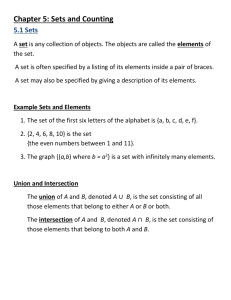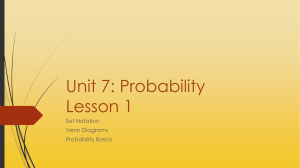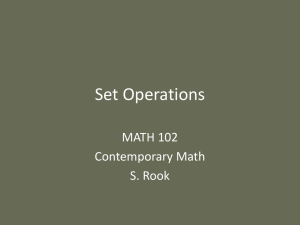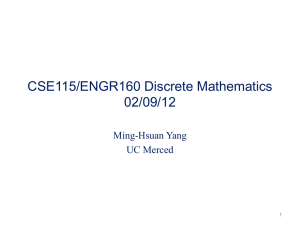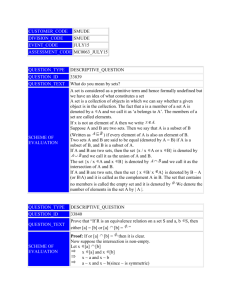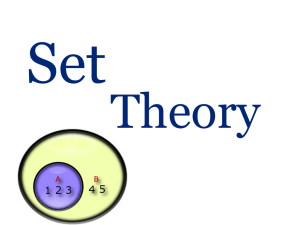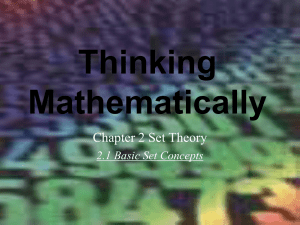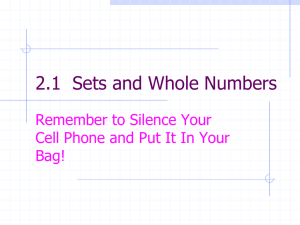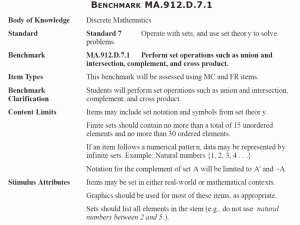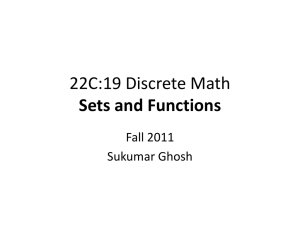ELEMENTARY SET THEORY - Mc Jeve Gindap
advertisement
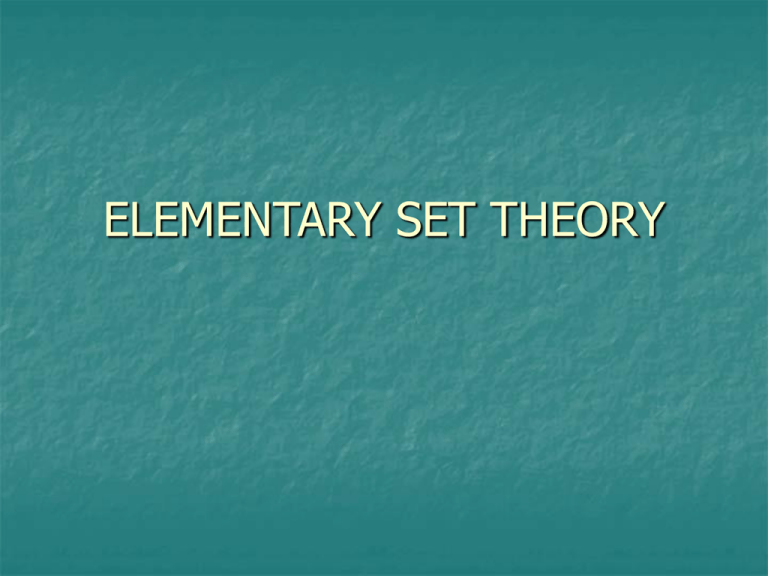
ELEMENTARY SET THEORY
Sets
A set is a well-defined collection of
objects.
Each object in a set is called an element
or member of the set.
The elements or objects of the set are
enclosed by a pair of braces { }.
Notations
Capital or uppercase letters are usually
used to denote sets while small or
lowercase letters denote elements of a
set.
denotes “is an element of” or “belongs
to”
denotes “is not an element of” or “does
not belong to”
Example
Let A – the set of letters in the English
alphabet
B – the set of primary colors
C – the set of positive integers
gA
orange B
100 C
Ways of Describing a Set
List (or roster) method describes a set by
enumerating the elements of the set.
A = {a, b, c, d,…,z}
B = {red, yellow, blue}
C = {1, 2, 3, 4,…}
Rule (or set builder) method describes a set
by a statement or a rule.
A = {x|x is an English alphabet}
B = {a|a is a primary color}
C = {y|y is a positive integer}
Definition of Terms
The cardinality of a set A, or the cardinal
number of A, denoted as n(A), is the number of
elements in A.
n(A) = 26, n(B) = 3, n(C) =
A set is finite if there is one counting number
that indicates the total number of elements in
the set.
A and B are finite sets.
A set is infinite if in counting the elements, we
never come to an end.
C is an infinite set.
Definition of Terms
The null set or empty set, denoted by the
symbol , is the set that contains no elements,
that is, A is empty iff n(A) = 0.
D = {x|x is a month in the Gregorian
calendar with less than 28 days}
n(D) = 0, so D =
A singleton set is a set that contains only one
element, that is, B is a singleton set iff n(B) = 1.
E = {y|y is prime number, 5 < y < 10}
Definition of Terms
Sets A and B are equal if they have the
same elements.
Set A is a subset of B, denoted as A B, iff
every element of A is also an element of B.
Laws of subset:
Every set is a subset of itself, that is, A A, for
any set A.
The null set is a subset of any set, that is, A,
for any set A.
Definition of Terms
Example: Subset
G = {x|x is an integer}
F = {y|y is a whole number}
C = {z|z is a positive integer}
C G because every element of C is
found in G.
F C because 0F but 0C.
Definition of Terms
Set A is a proper subset of B, denoted AB, if
A is a subset of B and there is at least one
element of B that is not in A. That is, AB iff
AB and AB.
P = {1, 3, 5, 7}
Q = {3, 7}
Then, QP
The set containing all of the elements for any
particular discussion is called the universal set,
denoted as U.
Exercise
Describe the following sets using the list
method and give the set cardinality:
a.
b.
c.
d.
A = {x|x is a natural number which is 1 less than a
multiple of 3}
B = {a|a is a rational number whose value is 2/3}
C = {b|b is a vowel that appears in the phrase “set
of vowels”}
D = {z|z is an even prime integer greater than 2}
Exercise
Describe the following sets using the rule
method:
a.
b.
c.
F = {0, 1, 8, 27, 64, 125, 216, …}
G = {…, -30, -20, -10, 0, 10, 20, 30, 40, …}
H = {1, 2, 3, 5, 7, 11, 13, 17, 19, 23, …}
Exercise
Determine which of the following statements
are true and which are false:
a.
b.
c.
d.
e.
f.
g.
h.
N
{1, 2, 3} N
{0} N
{1, 2, 3} {1, 2, 3}
1 {1, 2, 3}
n(N) = 1010
A B n(A) > n(B)
{3} N
The Power Set
Given a set S, the power set of S is the set
of all subsets of the set S. The power set
of S is denoted by P(S) or (S).
Example:
S = {0, 1, 2}
(S) = {, {0}, {1}, {2}, {0, 1}, {0, 2},
{1, 2}, {0, 1, 2}}
Note that the empty set and the set itself are
members of this set of subsets.
The Power Set
If a set has n elements, then its power set
has 2n elements.
Exercise:
What is the
What is the
What is the
null set?
What is the
power set of A = {x, y, z}?
power set of the null set?
power set of the power set of the
power set of B = {0, {1}, 3, {2, 4}}
SET OPERATIONS
Union
Let A and B be sets. The union of the sets
A and B, denoted by A B, is the set that
contains those elements that are either in
A or in B, or in both.
A B = {x|x A x B}
Example:
A = {1, 3, 5} and B = {1, 2, 3}
A B = {1, 2, 3, 5}
Union
Venn Diagram
Intersection
Let A and B be sets. The intersection of
the sets A and B, denoted by A B, is the
set containing those elements in both A
and B.
A B = {x|x A x B}
Example:
A = {1, 3, 5} and B = {1, 2, 3}
A B = {1, 3}
Intersection
Venn Diagram
Disjoint
Two sets are called disjoint if their
intersection is the empty set.
AB={}
Example:
A = {1, 3, 5, 7, 9}
B = {2, 4, 6, 8, 10}
A B = , then A and B are disjoint
Difference
Let A and B be sets. The difference of A and B,
denoted by A – B, is the set containing those
elements that are in A but not in B.
The difference of A and B is also called the
complement of B with respect to A.
A – B = {x|x A x B}
Example:
A = {1, 3, 5} and B = {1, 2, 3}
A – B = {5}
Difference
Venn Diagram
Complement
Let U be the universal set. The complement of
the set A, denoted by A’, is the complement of
A with respect to U. In other words, the
complement of set A is U – A.
A’ = {x|x A}
Example:
A = {a, e, i, o, u}
where the universal set is the set of letters
in the English alphabet
A’ = {y|y is a consonant}
Complement
Venn Diagram
Cartesian Products
The order of elements in a collection is often
important. Since sets are unordered, a different
structure is needed to represent ordered
collections. This is provided by ordered n-tuples.
The ordered n-tuple (a1, a2,…an) is the ordered
collection that has a1 as its first element, a2 as
its second element,…, and an as its nth element.
Two ordered n-tuples are equal iff each
corresponding pair of their elements is equal.
Cartesian Products
Let A and B be sets. The Cartesian
product of A and B, denoted by A x B, is
the set of all ordered pairs (a, b) where a
A and b B.
A x B = {(a, b)|a A b B}
Example: A = {1, 2} and B = {a, b, c}
A x B = {(1, a), (1, b), (1, c), (2, a),
(2, b), (2, c)}
Note: A x B B x A
Cartesian Products
The Cartesian product of sets A1, A2,…, An,
denoted by A1 x A2 x … x An is the set of
ordered n-tuples (a1, a2,…, an), where ai
belongs to Ai for i = 1, 2,…, n.
A1 x A2 x … x An = {(a1, a2, …, an) | ai Ai
for i = 1, 2, …, n}
Example: A = {0, 1}, B = {1, 2},
C = {0, 1, 2}, find A x B x C.
Exercise
Let A be the set of students who live one
km from school and let B be the set of
students who walk to classes. Describe
the students in each of these sets.
a.
b.
c.
d.
A
A
A
B
B
B
–B
–A
Exercise
Let A = {1, 2, 3, 4, 5} and B = {0, 3, 6}. Find
a.
b.
c.
d.
AB
AB
A–B
B–A
Let A = {0, 2, 4, 6, 8, 19}, B = {0, 1, 2, 3, 4,
5, 6} and C = {4, 5, 6, 7, 8, 9, 10}
a. A B C
b. A B C
c. (A B) C
d. (A B) C
Properties of Set Union
1.
2.
3.
4.
5.
For any sets A, B, and C,
The union of any set with the null set is the set
itself. A = A
The union of any set with itself is the set itself.
AA=A
Set Union is commutative. A B = B A
Set Union is associative. (A B) C = A (B
C)
Any set is a subset of its union with another
set. A A B
Properties of Set Intersection
1.
2.
3.
4.
5.
6.
For any sets A, B, and C,
The intersection of any set with the null set is the null
set. A =
The intersection of any set with itself is the set itself. A
A=A
Set Intersection is commutative. A B = B A
Set Intersection is associative. (A B) C = A (B
C)
The intersection of any given set with another set is a
subset of the given set. A B A
A (B C) = (A B) (A C)
A (B C) = (A B) (A C)
Properties of Set Difference
1.
2.
3.
4.
5.
For any sets A, B, and C,
The removal of the null set from any set has
no effect on the set. A – = A
The removal of the elements of any set from
itself will leave the empty set. A – A =
No elements can be removed from the null set.
–A=
The result of removing the elements of a set
from any given set is a subset of the given set.
A–BA
A – (B C) = (A – B) (A – C)
A – (B C) = (A – B) (A – C)
Properties of Set Cardinality
1.
2.
3.
For any sets A, B, and C,
|A B| = |A| – |A – B|
|A B| = |A| + |B| – |A B|
|A – B| = |A| – |A B|

